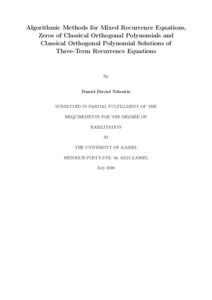| dc.date.accessioned | 2019-09-05T06:05:50Z | |
| dc.date.available | 2019-09-05T06:05:50Z | |
| dc.date.issued | 2019-07 | |
| dc.identifier | doi:10.17170/kobra-20190904651 | |
| dc.identifier.uri | http://hdl.handle.net/123456789/11294 | |
| dc.language.iso | eng | |
| dc.rights | Urheberrechtlich geschützt | |
| dc.rights.uri | https://rightsstatements.org/page/InC/1.0/ | |
| dc.subject | Zeros of orthogonal polynomials | eng |
| dc.subject | Interlacing properties | eng |
| dc.subject | quasi-orthogonality | eng |
| dc.subject | Three-term recurrence relation | eng |
| dc.subject.ddc | 510 | |
| dc.title | Algorithmic Methods for Mixed Recurrence Equations, Zeros of Classical Orthogonal Polynomials and Classical Orthogonal Polynomial Solutions of Three-Term Recurrence Equations | eng |
| dc.type | Habilitation | |
| dcterms.abstract | Using an algorithmic approach, we derive classes of mixed recurrence equations satisfied by classical orthogonal polynomials. Starting from certain structure relations satisfied by classical orthogonal polynomials or their connection formulae, we show that our mixed recurrence equations are structurally valid. However, they couldn't be easily obtained with classical methods and for this reason, our algorithmic approach is important. The main algorithmic tool used here is an extended version of Zeilberger's algorithm. As application of the mixed recurrence equations: we investigate interlacing properties of zeros of sequences of classical orthogonal polynomials; we prove quasi-orthogonality of certain classes of polynomials and determine the location of the extreme zeros of the
quasi-orthogonal polynomials with respect to the end points of the interval of orthogonality of the polynomial sequence, where possible; we find bounds for the extreme zeros of classical orthogonal polynomials.
Every orthogonal polynomial system $\{p_n(x)\}_{n\geq 0}$ satisfies a three-term recurrence relation of the type
\[
p_{n+1}(x)=(A_nx+B_n)p_n(x)-C_np_{n-1}(x)~ (n=0,1,2,\ldots, p_{-1}\equiv 0),
\]
with $C_nA_nA_{n-1}>0$. Moreover, Favard's theorem states that the converse is also true. A general method to derive the coefficients $A_n$, $B_n$, $C_n$ in terms of the polynomial coefficients of the divided-difference equations satisfied by orthogonal polynomials on a quadratic or $q$-quadratic lattice is revisited. The Maple implementations rec2ortho of Koornwinder and Swarttouw (1998) or retode of Koepf and Schmersau (2002) were developed to identify classical orthogonal polynomials knowing their three-term recurrence relations. The two implementations rec2ortho and retode do not handle classical orthogonal polynomials on a quadratic or $q$-quadratic lattice. We extend the Maple implementation retode of Koepf and Schmersau (2002) to cover classical orthogonal polynomials on quadratic or $q$-quadratic lattices and to answer as application an open problem submitted by Alhaidari (2017) during the 14th International Symposium on Orthogonal Polynomials, Special Functions and Applications. | eng |
| dcterms.accessRights | open access | |
| dcterms.creator | Tcheutia, Daniel Duviol | |
| dcterms.dateAccepted | 2019-07-17 | |
| dcterms.extent | iv, 110 Seiten | |
| dc.contributor.corporatename | Kassel, Universität Kassel, Fachbereich Mathematik und Naturwissenschaften, Institut für Mathematik | |
| dc.contributor.referee | Koepf, Wolfram (Prof. Dr.) | |
| dc.type.version | acceptedVersion | |

